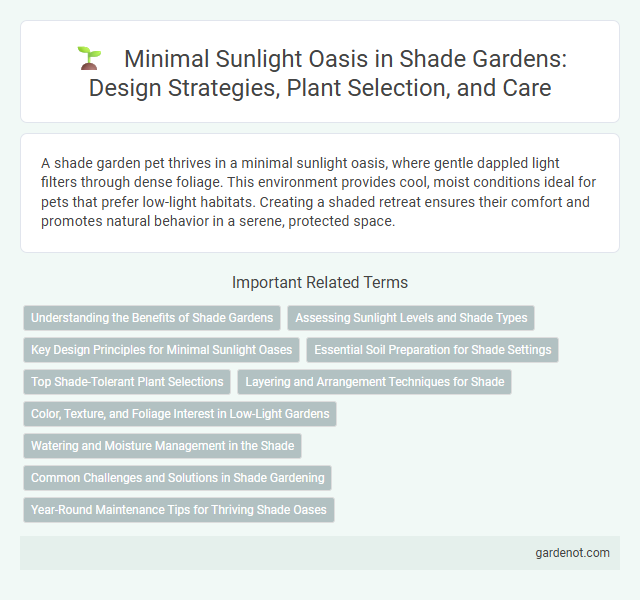A shade garden pet thrives in a minimal sunlight oasis, where gentle dappled light filters through dense foliage. This environment provides cool, moist conditions ideal for pets that prefer low-light habitats. Creating a shaded retreat ensures their comfort and promotes natural behavior in a serene, protected space.
Understanding the Benefits of Shade Gardens
Shade gardens thrive in minimal sunlight, creating a cool, tranquil oasis that supports diverse plant species like ferns, hostas, and astilbes. These gardens improve soil moisture retention, reduce water evaporation, and provide a natural habitat for shade-preferring wildlife, promoting biodiversity. Shade gardens also enhance outdoor living spaces by offering a comfortable retreat from harsh sun exposure, contributing to lower ambient temperatures and increased energy efficiency around homes.
Assessing Sunlight Levels and Shade Types
Assessing sunlight levels in a shade garden involves measuring the intensity and duration of light exposure, typically categorized into deep shade, partial shade, and dappled shade. Understanding these shade types allows gardeners to select plants that thrive under specific light conditions, such as ferns for deep shade or hostas for partial shade. Accurate evaluation of sunlight patterns throughout the day ensures optimal plant health and a thriving minimal sunlight oasis.
Key Design Principles for Minimal Sunlight Oases
Key design principles for a minimal sunlight oasis include selecting shade-tolerant plants such as hostas, ferns, and astilbes that thrive in low light conditions. Incorporating reflective surfaces like light-colored mulch and garden ornaments enhances available light, while layering plants of varying heights creates depth and visual interest. Proper soil preparation and moisture retention techniques ensure healthy growth in shaded environments, fostering a serene and thriving shade garden.
Essential Soil Preparation for Shade Settings
Preparing soil for a shade garden requires rich, well-draining organic matter to retain moisture while preventing waterlogging. Incorporate compost, leaf mold, and well-aged manure to enhance soil fertility and structure for low-light plant growth. Soil pH should be slightly acidic to neutral (6.0-7.0) to optimize nutrient availability in shaded environments.
Top Shade-Tolerant Plant Selections
Top shade-tolerant plant selections for a minimal sunlight oasis include hostas, ferns, and astilbes, which thrive in low-light conditions while adding texture and color. These plants are ideal for creating a lush, green refuge in shaded garden areas, requiring minimal maintenance and water. Incorporating Japanese forest grass and coral bells further enhances diversity with vibrant foliage and delicate blooms.
Layering and Arrangement Techniques for Shade
Creating a minimal sunlight oasis in a shade garden relies heavily on strategic layering and arrangement techniques to maximize visual interest and plant health. Use a combination of ground covers, mid-height foliage, and taller shade-tolerant plants like hostas, ferns, and shade-loving shrubs to establish depth and texture. Arrange plants with varied leaf shapes, colors, and growth habits to enhance contrast and maintain airflow, ensuring a thriving and dynamic shaded environment.
Color, Texture, and Foliage Interest in Low-Light Gardens
Low-light gardens thrive with a strategic mix of plants emphasizing vibrant color, varied texture, and dynamic foliage to create a minimal sunlight oasis. Shade-tolerant species such as hostas, ferns, and heucheras offer rich greens, purples, and variegated leaves that add depth and visual intrigue. Incorporating textured leaves and contrasting shapes enhances the garden's appeal, ensuring year-round interest despite limited sunlight.
Watering and Moisture Management in the Shade
Shade gardens thrive with consistent watering tailored to low-light conditions, promoting healthy root development and vibrant foliage. Maintaining optimal soil moisture through deep watering prevents dryness and nutrient deficiencies in shaded areas. Using mulch conserves moisture, moderates soil temperature, and reduces watering frequency for a sustainable shade garden oasis.
Common Challenges and Solutions in Shade Gardening
Shade gardens often face common challenges such as limited light, poor soil drainage, and pest infestations that hinder plant growth. Selecting shade-tolerant plants like hostas, ferns, and astilbes, along with amending soil with organic matter, improves moisture retention and nutrient availability. Implementing proper spacing and mulching reduces pest problems and supports a thriving minimal sunlight oasis.
Year-Round Maintenance Tips for Thriving Shade Oases
Consistent moisture control and mulching are essential for maintaining a healthy shade garden, as these practices prevent soil drying and protect root systems year-round. Selecting shade-tolerant plants such as hostas, ferns, and astilbes ensures continuous growth despite limited sunlight. Regular pruning and monitoring for pests enhance plant vigor, creating a thriving, minimal sunlight oasis throughout all seasons.
Minimal sunlight oasis Infographic

 gardenot.com
gardenot.com